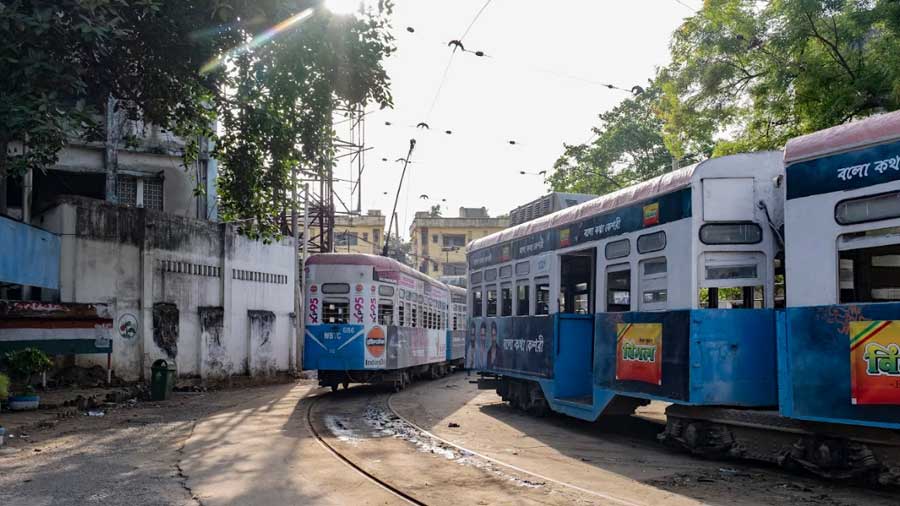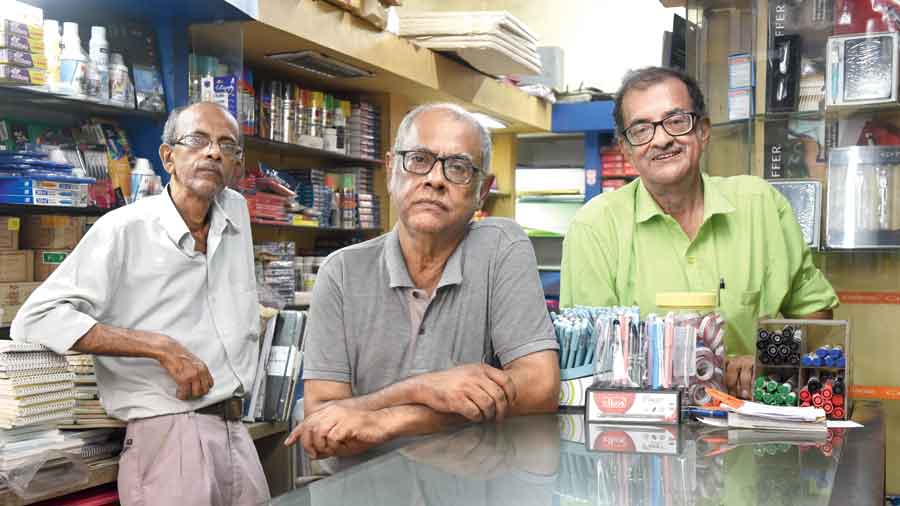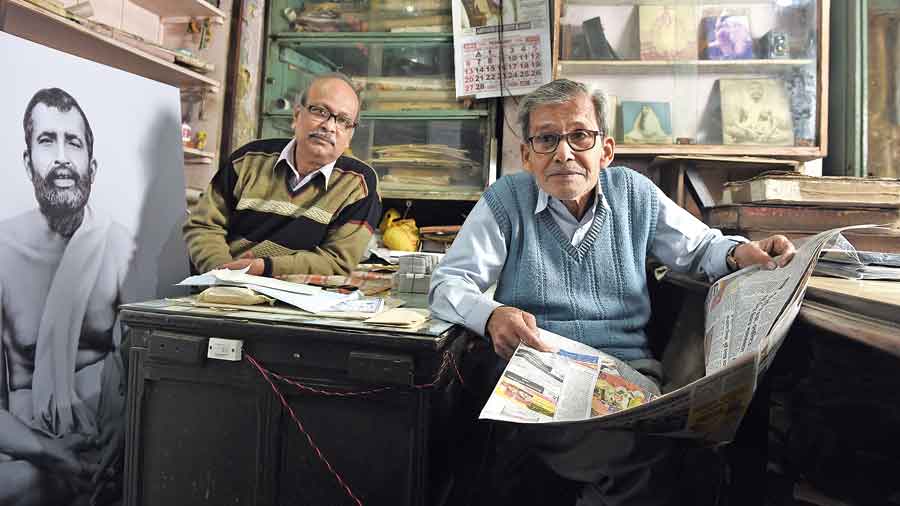The long legacy of Kolkata trams has always kept a fine balance between romance and reality. But almost 150 years after the first horse-drawn tram ran in between Sealdah and Armenian Ghat Street, how do the city’s old faithfuls fare when newer modes of transport are changing the face of the metropolis?
The answer is stasis, at best, and imminent extinction, at worst. In spite of being pollution-free and bafflingly inexpensive, trams are heading towards a slow death in a city that seems to have taken their presence for granted.
Only a handful of drivers are entrusted with the three functional tram routes in the city right now, most of whom are approaching retirement by the end of the coming year.
The conductors of these vehicles, too, are men pushing the limits of their physical tenacity well into the sunset years of life.
When My Kolkata went around the tram depots of Shyambazar, Gariahat and Tollygunge, we encountered resistance and reticence from employees of West Bengal Transport Corporation Limited (previously, tram drivers, conductors and management were employed by Calcutta Tramways Company), who hesitated to open up about the existential concerns of trams and those who run them, largely due to fears of bureaucratic consequences.
If and when they did speak, the undercurrent was that of accepting their present plight as inevitable, of coming to terms with the fact that even if trams in Kolkata manage to survive, they will never thrive.
We knew so many people earlier who’d travel solely by trams…Nobody does that anymore
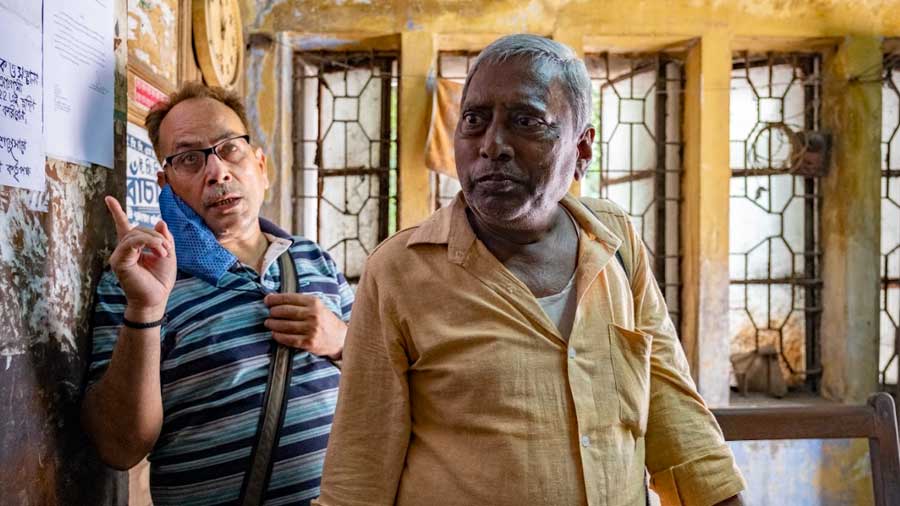
Sanjay Tiwari (left) and Nand Kishore Singh have both spent the majority of their lives as conductors on Kolkata’s trams Ritagnik Bhattacharya/My Kolkata
Starting at the Shyambazar tram depot, where trams are currently not in operation due to construction works on the Shyambazar route, we found a sense of ennui akin to sitting in a stationary tram. Not much happened, not much changed. Time moved like a truant kid grudgingly going to school.
“We used to have eight to 10 trips every day when we joined. At present, we’re lucky if we manage two or three. With the construction going on right now, we don’t have any work,” said Sanjay Tiwari, conductor posted at the Shyambazar tram depot.
His daily routine for the past month or so has been to come to the depot and find a way to occupy themselves till their official hours for the day are up. There is not much to do, except sitting around, watching Facebook reels and finishing half a dozen cups of tea.
“Around 100 tram cars used to cover the city in the 1980s and ’90s. As of today, there are hardly seven or eight,” commented Tiwari with a sense of indifference that one usually reserves for chatter about the weather.
“Naturally, the number of passengers has gone down as a result. We knew so many people earlier who’d travel solely by trams. If, for whatever reason, tram services were off for the day, they’d cancel their travel plans altogether. Nobody does that anymore,” said Nand Kishore Singh, colleague of Tiwari.
New tram drivers are nowhere to be found
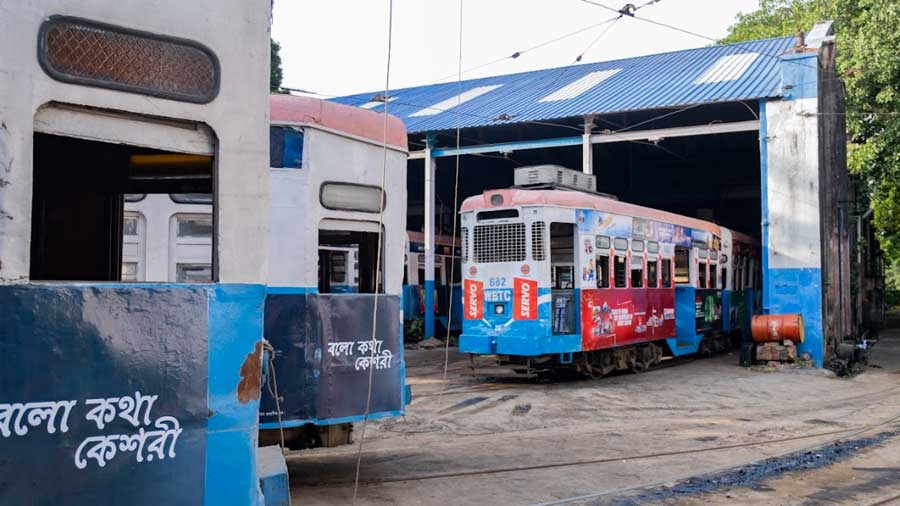
Tram driver Kalikanta Thakur believes trams have not become slower, rather the space for them to navigate has shrunk Ritagnik Bhattacharya/My Kolkata
No drivers were present at the Shyambazar depot as all of them are supposed to be at home (or in their assigned quarters) until the Shyambazar tram route comes alive once more. Our next stop took us to the Esplanade tram depot, which wore a deserted look, as if ransacked of people and purpose. After a few minutes of searching and seeking, we came across Swapan Kumar Dutta, traffic superintendent and in-charge of operations at the depot.
Dutta clarified how one of the biggest issues plaguing Kolkata’s trams right now is the lack of recruitment. New tram drivers are nowhere to be found, which means that the present lot of drivers, most of whom are on the verge of retiring, will soon leave a vacuum that might shut down trams altogether.
“There are very few people willing to drive trams these days. Most drivers would rather handle buses. Moreover, it’s not easy to recruit drivers. They have to receive training for a minimum of three months, before they can be trusted with the steering,” he explained.
“Recently, the Board of Directors met and decided to take 50 new drivers, but it’s easier said than done. Finding these five people won’t be a walk in the park,” he said.
I love the work that I do, although it’s not the kind of life I dreamt of having
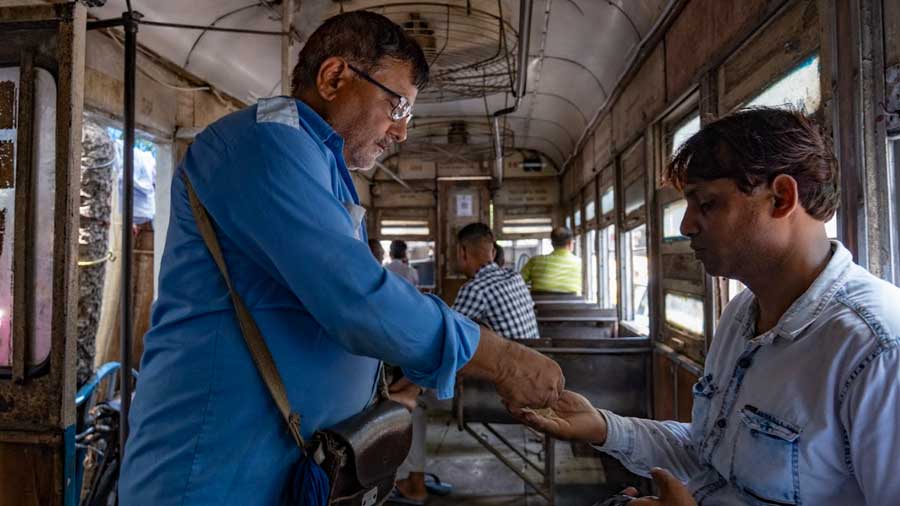
Ganesh Tiwari has been a tram conductor in Kolkata for almost four decades Ritagnik Bhattacharya/My Kolkata
Hopping onto the next tram from Esplanade to Gariahat, we met Ganesh Tiwari, who has been a tram conductor for the last 38 years. “The government was supposed to increase the number of trams, but it didn’t. I still feel that Didi (Mamata Banerjee) wants to increase trams, and I hope it’ll happen soon,” said Tiwari, with a grimace.
Born and brought up in Benares, Tiwari came to Kolkata as a teenager looking for a better life. With two years to go before his retirement, he did not seem to regret his decision, although the longing for more still lurked.
“My son is an engineer and my daughter works in a bank. Both are settled in Bengaluru. I work eight-hour shifts during the day, and my evenings are spent watching news. I try to go back to Benares whenever I can because many of my family members are still there. As for my job, I love the work that I do, although it’s not the kind of life I dreamt of having,” he said.

Tiwari could only sigh when asked about his thoughts on the dwindling passengers in Kolkata’s trams Ritagnik Bhattacharya/My Kolkata
Switching between sitting on the metal benches and standing to invite passengers onboard, Tiwari pondered in silence when asked about what could be done to improve his life as a conductor. “Nothing, I’m good,” he muttered, barely audible amidst the screeching and squealing of the tram. Having rung his bell to help disembark a passenger, Tiwari returned to sit down, intercepting our glance towards the driver, who had barely broken a sweat on an oppressive summer afternoon.
“Don’t go to him. He won’t talk,” said Tiwari, advising us to speak to drivers at the Gariahat tram depot instead.
It’s better to drive trams in the present day as compared to 35 years ago

Ajit Chandra Mondol said he preferred driving today’s trams as compared to the ones he started out with some 35 years ago Ritagnik Bhattacharya/My Kolkata
As it turned out, drivers were hard to spot at the Gariahat tram depot. The few that were present had changed out of their uniforms and showed little desire in verifying their professional identities. That was until a certain Ajit Chandra Mondol answered our call.
In his late 50s, Mondol transmitted a rare sense of optimism about Kolkata’s trams. “It’s better to drive trams in the present day as compared to 35 years ago, when I first joined,” he said. Why so? “In the past, trams came with just four wheels, which wobbled frequently during the journey. Nowadays there are trams with 12 wheels and with much stronger steel carriages,” he observed.
As we tried to segue into the next question, Mondal gestured that our time was up. The management personnel at the depot, who were monitoring everything Mondal was asked, felt he had said enough.
We might fall asleep if we get to sit

Kalikanta Thakur could not imagine his life outside his identity as a tram driver Ritagnik Bhattacharya/My Kolkata
Our final stop for the day was the Tollygunge tram depot where, at last, two drivers spoke without a leash. “I came to Kolkata as a 21-year-old from Bihar. In two years’ time, I’ll be eligible for retirement. For all these years, I’ve only driven trams. That’s been my profession and my identity,” said Kalikanta Thakur, a driver on the route between Tollygunge and Ballygunge.
In close to three decades of navigating trams across the length and breadth of Kolkata, Thakur has grown accustomed to the strains that come with the job. So much so that he prefers standing to sitting while driving, and would not be in favour of the authorities introducing seats for drivers. “We might fall asleep if we get to sit,” chuckled Thakur, though he clarified he was not joking.
“As drivers, our job is to remain standing, to remain alert,” he continued, before recollecting how in the old days of reserved tracks — when trams could go on their designated routes without having to make space for other vehicles on the road — things were so much simpler.
The loss of the reserved track system is a common grievance among drivers, as it gave priority status to trams on the roads, ensuring other vehicles could not move through the tramlines.
“Driving was much easier back then. Signals were also few and far between. I remember there used to be only two main signals on the routes I’d drive back then, one in Lake Town and the other in Gariahat. Traffic police officers would be very cooperative; we’d even use hand signals at times to communicate,” said Thakur.
I have nothing to say to the government. They know what we have and what we don’t
Thakur said trams were faster than buses in the good old days. The reason why they seem slower now is because of a lack of space, not speed. With less space comes greater chance of accidents, something Thakur is wary of during each second of his three daily trips.
Even after a lifetime of driving trams, Thakur had a glint in his eye when narrating how greater intricacy is required to manoeuvre trams in today’s chock-a-block streets of Kolkata, as compared to when he began.
But his enthusiasm took a back seat when asked about the future, about what changes he would like to recommend to help improve the lives of those like him. “I have nothing to say to the government. They know what we have and what we don’t. Personally, I’m happy,” he said, before reluctantly adding, “I’ve got to keep myself happy, you know. That’s what gives me strength.”
The brakes in the trams must improve
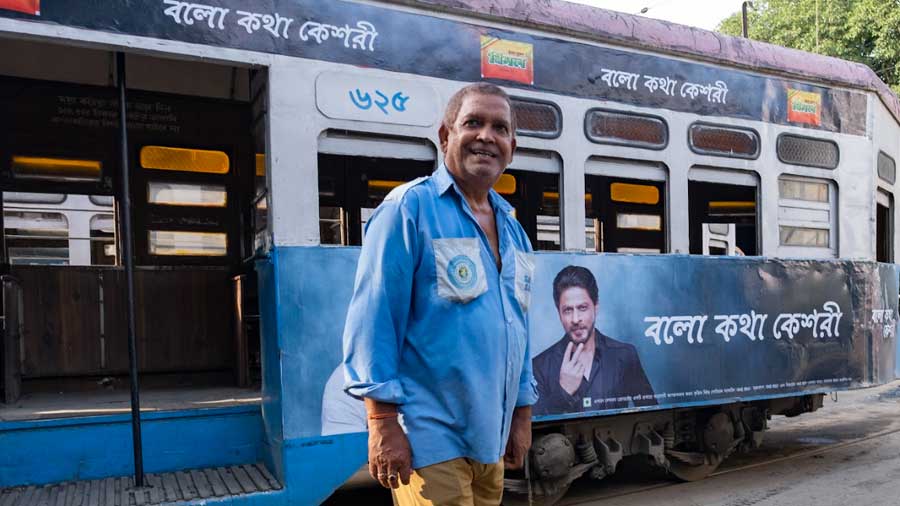
Binod Jha rued the elimination of reserved tracks for trams on the roads of Kolkata Ritagnik Bhattacharya/My Kolkata
Binod Jha, one of Thakur’s fellow drivers on the Ballygunge-Tollygunge route, was in agreement on the greater convenience of driving in the past. “Previously, we could complete a trip from Ballygunge to Tollygunge in 45 minutes. Today, the same trip takes almost two hours. Back in the day, cars used to ply on the left side of the road, so that we could progress comfortably on the right.”
“But ever since reserved tracks have disappeared, cars rush to the right whenever they get the chance, often straight along the tramline. I’d also like to mention the poor state of the brakes these days. That’s something that must improve,” said Jha, who also came to Kolkata from Bihar, in 1983, aged 23.
Having started out in a paan shop in Liluah, Jha got the tram driver’s job based on the nominee system, which allowed drivers working for the Calcutta Tramways Company (CTC) to nominate their sons to take over after their retirement. Almost all the tram drivers in Kolkata who are ferrying passengers in 2022 are beneficiaries of the nominee system, which was disbanded in 1992.
The rest of us are entitled to nothing once we retire
Whereas the likes of Jha had numerous trips to cover earlier, these days he slips into idleness for the better part of his working hours. Ruminating over what retirement holds, Jha lamented not being eligible for pension, even after decades of committed service. “Towards the end of the CPI(M) regime in West Bengal, a provision had been passed to provide a pension amount of Rs 1,800 per month to retired drivers via a trustee board. Most drivers, like myself, refused it at the time since the amount wouldn’t be enough to look after our families,” he said.
“On average, only 30 out of 100 drivers were onboard with the provision. They’re the ones who’ll be getting a bare minimum pension, while the rest of us are entitled to nothing once we retire,” said Jha, producing a wry smile.
Unlike the drivers elsewhere, Jha did not run out of time. He stared at us blankly, wondering if we had any more questions for him. Given the choice, it felt like he could speak all day, fetching out stories from a career that has seen him stationed at practically every tram depot in the city. “I kept getting posted to the Rajabazar tram depot in my initial days…I’ve spent so much time there,” said Jha, whose next utterance was interrupted as he was called in for work.
“Time to go for your next ride?” we asked.
“No, I need to go fill the water for babu,” he replied.
